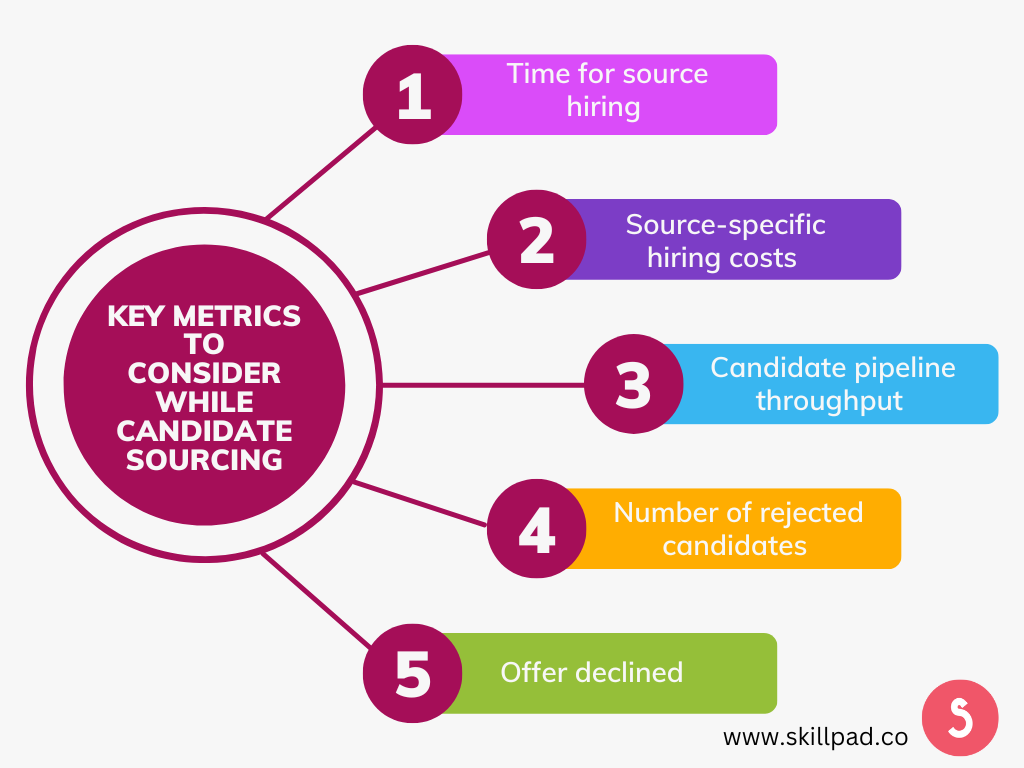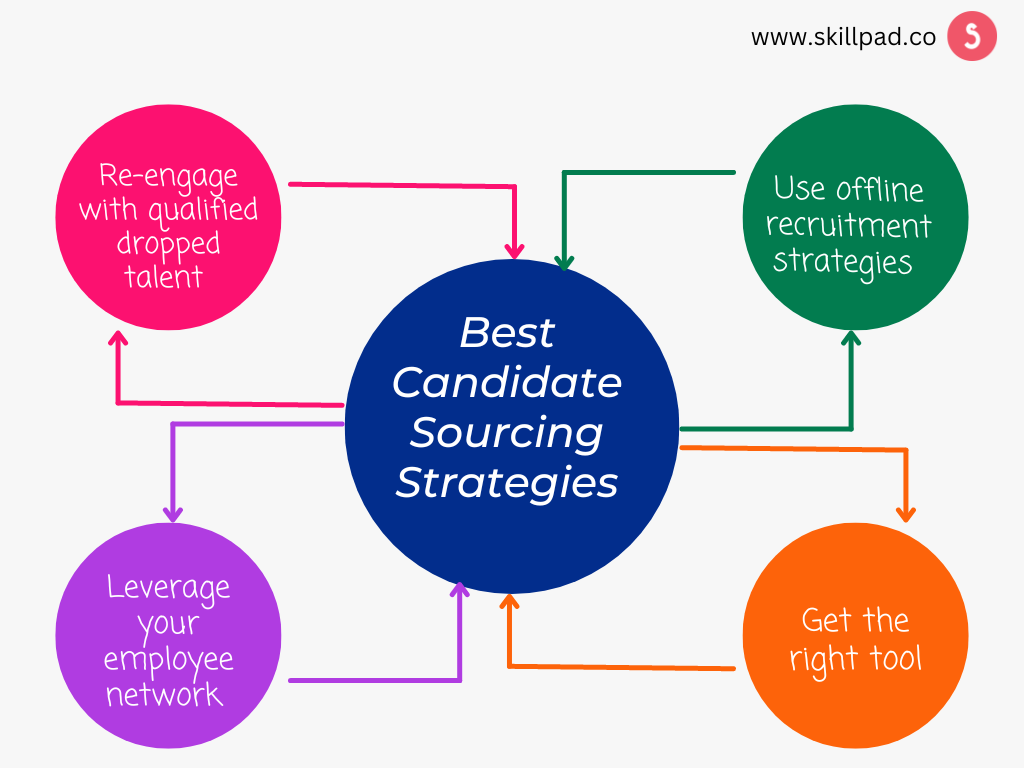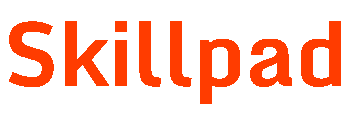The skill gap and talent shortage are serious recruitment issues. According to McKinsey, 87% of respondents are already experiencing the talent gap.
The talent gap problem will become more difficult in the future as a result of high resignation rates and hybrid work environment demand.
A study shows that there won’t be enough people to fill 85 million job openings by 2030, which will cost $8.5 trillion.
Businesses can avoid this situation with the proper talent relationship management system. They can follow the candidate sourcing strategy to find the right talent for the
organization.
Let’s follow this guide to learn all about candidate sourcing.
What is Candidate Sourcing?
Candidate sourcing means finding the best people with the right skills, education, and interests for open jobs at your company or at the company of a client. Candidate sourcing looks for both active and passive candidates in order to find the best candidate for the job.
What is Candidate Sourcing Software?
Candidate sourcing software allows you to easily source, screen, and schedule interviews with candidates. In addition, modern candidate sourcing software lets you post to multiple job boards with a single click, create a personalized career page in minutes, efficiently screen candidates, and much more.
Candidate Sourcing Vs Recruiting: Key Differences
While sourcing and recruiting are distinct, they work well together. Sourcing lays the groundwork for successful recruitment.
As previously stated, sourcing is the process of looking for candidates, while recruiting is the process of evaluating them.
The first step in making a successful hire is to find candidates.
First, the hiring department figures out what qualifications and skills are needed, and then it looks for the best candidates. This sourcing goes beyond simply posting on a job board; it involves actively seeking out the talent you require and reaching out to them.
In these conversations, your recruiters would start talking to qualified candidates about the open role or future open roles, trying to get them to apply or find out how interested they were. But, again, the only reason to use sourcing is to build a reliable pool of applicants from which recruiters can pull when they need to hire people quickly.
The term “recruiting” refers to the entire hiring process. It involves finding qualified candidates to build a talent pool, going over resumes, holding interviews, and getting new employees up to speed.
Companies need a lot of people to choose from if they want to be sure they can do each of the steps above. As a result, sourcing should be an essential component of any recruitment strategy.
How Does Candidate Sourcing Work?
While the talent sourcing program varies from company to company, most recruiters include four basic steps in their process, which are as follows:
- Developing a sourcing strategy and plan. This includes identifying candidates during the company’s culture and current or future positions. The step may also include determining where the sources will look for candidates.
- Implementing the sourcing strategy and plan. Sourcers locate and network with the qualified candidates identified during the planning process. For example, connecting with people on social media, emailing and communicating with candidates, attending events, or browsing alumni and trade school events.
- Assessing the talent pool. Once a sufficient number of candidates has been assembled, sourcers can vet the list to determine which candidates they believe fit in with the company and best fulfill the duties of a specific job.
- Moving qualified candidates through the talent pipeline. Once recruiters have vetted their list for the best talent, they can pass it on to the people in charge of the talent pipeline—a smaller list of candidates deemed qualified to enter the hiring process.
Key Metrics to Consider While Sourcing Candidates
The key to competitively sourcing talent is to measure your sourcing process over time to optimize or realign resources invested in various sources.
Here are five diagnostic candidate sourcing metrics to monitor:

Time for source hiring
The metric is the time it takes to hire a candidate from the time they are first sourced. These metrics aid in allocating resources to channels that produce the right fit at the right time. It also helps you find and fix all bottlenecks in the hiring process, which affects the time it takes to hire someone.
Source-specific hiring costs
The metric allows you to track the returns on your sourcing investments, or ROI.
Candidate pipeline throughput
The candidate pipeline throughput, also called funnel throughput, is the rate at which candidates convert at each stage of the hiring process. It is especially effective for roles that hire frequently or in large numbers. It tells you how good the applicants are that come from a certain source, so you can figure out which sources or job boards work for you and which ones don’t.
Number of rejected candidates
The metric provides information on rejected candidates and the source from which they came. This allows you to identify rejection patterns and drop or adjust channels that do not bring candidates who are a good fit for your roles. For example, if you notice that most of your rejected candidates came from LinkedIn, you can either revise your job description or eliminate the channel.
Offer declined
There are many reasons why candidates turn down job offers, such as counter-offers from their current employers, not wanting to move, low pay, etc. If you know why a candidate turned down an offer, you can change your sourcing and recruiting methods to find and hire the right people.
Benefits of Using ATS for Candidate Sourcing
An applicant tracking system (ATS) is a tool businesses and recruitment agencies use to manage the hiring process. It makes it easier to keep track of the best candidates from the time they apply until they are hired.
Employers can use this tracking software to find out about potential employees and qualified candidates and store that information. In addition, ATS can help implement talent sourcing strategies in many ways, such as:
- Manage all your sourcing channels – job boards, career sites, referrals, social media, and so on – from a single platform.
- Post jobs to all major job boards, including Indeed, Adzuna, LinkedIn, and ZipRecruiter, and manage them all from a single location.
- Applicants from all sourcing channels will be funneled into a single system (the ATS) where you can manage them.
- All conversations with candidates are kept in one place (the conversations tab). Your co-sourcers can consult them at any time!
- Collaborate with your team on sourcing decisions, view candidate profiles, and leave comments for one another in a single, easily accessible location.
- Archive the best candidates in a talent pool, engage with them, and invite them to pursue appropriate roles as they become available.
- Create a thriving talent pool by saving the best profiles you find during the sourcing process.
- Post jobs on social media and monitor their status in the applicant tracking system. As a result, it is now much easier to find social talent.
- Improve your sourcing by obtaining reports on time to fill, cost per hire, and pipeline throughput.
Why Include Candidate Sourcing in Your Recruitment Strategy?
Adding candidate sourcing to your recruitment strategy can help reduce the resignation rate by hiring culture-fit candidates. It can also help with the following:
It raises the caliber of hires
When you actively seek out the best candidates, you better understand what the position and the company require, leading to better hires.
It broadens the hiring range
Talent sourcing helps organizations build a more diverse pool of candidates because it takes time to find the best person for an open position. Instead, they already have a pipeline of qualified candidates, which gives them more time and options for filling roles with more diverse talent.
It saves time and money on hiring
Talent sourcing cuts down on these costs because you’ll already have a pool of qualified candidates ready to fill jobs as they open up.
It strengthens your employer’s brand
The employer brand of a company is its reputation, and sourcing talent is a key part of building this brand.
When your company shows interest in candidates and keeps them up to date on open positions, initiatives, product updates, and employee stories, the company becomes more familiar and trustworthy to these passive candidates.
Best Candidate Sourcing Strategies
Here are some of the best candidate sourcing strategies to hire the perfect candidates for your job openings:

Re-engage with qualified dropped talent
If you take the time to find qualified candidates, you might end up with a good hire and candidates who are also qualified for other positions.
Utilize the past work of your team by starting each new search with the people who have already given your team time and who you have determined are qualified to work for your company. If you want to work well with candidates who have already been hired, you need to have a plan for how to get in touch with them.
Use offline recruitment strategies
There’s no denying that online channels increase your engagement. However, offline recruitment methods remain a powerful force. Going offline and meeting people in person at events is an excellent way to find new candidates.
For example, attend job-related, industry-specific conferences and events, or organize your meetups to bring together groups of people you want to meet.
Leverage your employee network
Organizations can increase their talent pool by recruiting through their employees’ networks. Hold candidate sourcing sessions with your team to find out if anyone in the networks of your employees would be a good fit for one of your open jobs.
Your employees can help you find untapped talent and get more candidates who know them to respond. For example, Facebook can show your employees different candidate search results based on their social graph, allowing you to find candidates you would not have found otherwise.
Get the right tool
Anyone who is sourcing has several balls in the air at the same time. Managing all that activity in documents and spreadsheets can quickly become overwhelming, but that’s what most recruiters had to do earlier.
When you use the right tools for recruiting, you can speed up your process, stay organized, and find the best candidates.
Top Candidate Sourcing Tools
Since we are on the topic of recruiting tools, let’s check out the best candidate sourcing tools:
Talentbin
Monster’s Talentbin is a massive database that contains millions of profiles. Its primary focus is locating passive candidates via boolean search and social media recruiting. They also give you a lot of information from candidates’ social media accounts that you can use to get in touch with them.
Zillionresumes
ZillionResumes.com is a resume aggregator that collects resumes from thousands of other sources. It provides you with the opportunity to find “hard-to-find” candidates. You can also get lists of resumes that match your search criteria from the platform.
HiringSolved
HiringSolved helps you find candidates from anywhere in the world and search in any language. It also has an interesting feature that lets you look for candidates who are similar to someone you upload to their system.
Parting Thoughts
Candidate sourcing tools can make it easy to find candidates for your organization using data-driven strategies. But artificial intelligence algorithms can help you only to a certain extent.
A humane approach is always essential to find the best candidate. And for that, you can always consult SkillPad.
We combine data-driven strategies with a human approach to find culture-fit candidates for your organization. We have a vast talent pool that can help you find the perfect candidate for a role.
Get in touch with our team today to learn more about our data-driven and human-driven candidate sourcing strategies.












